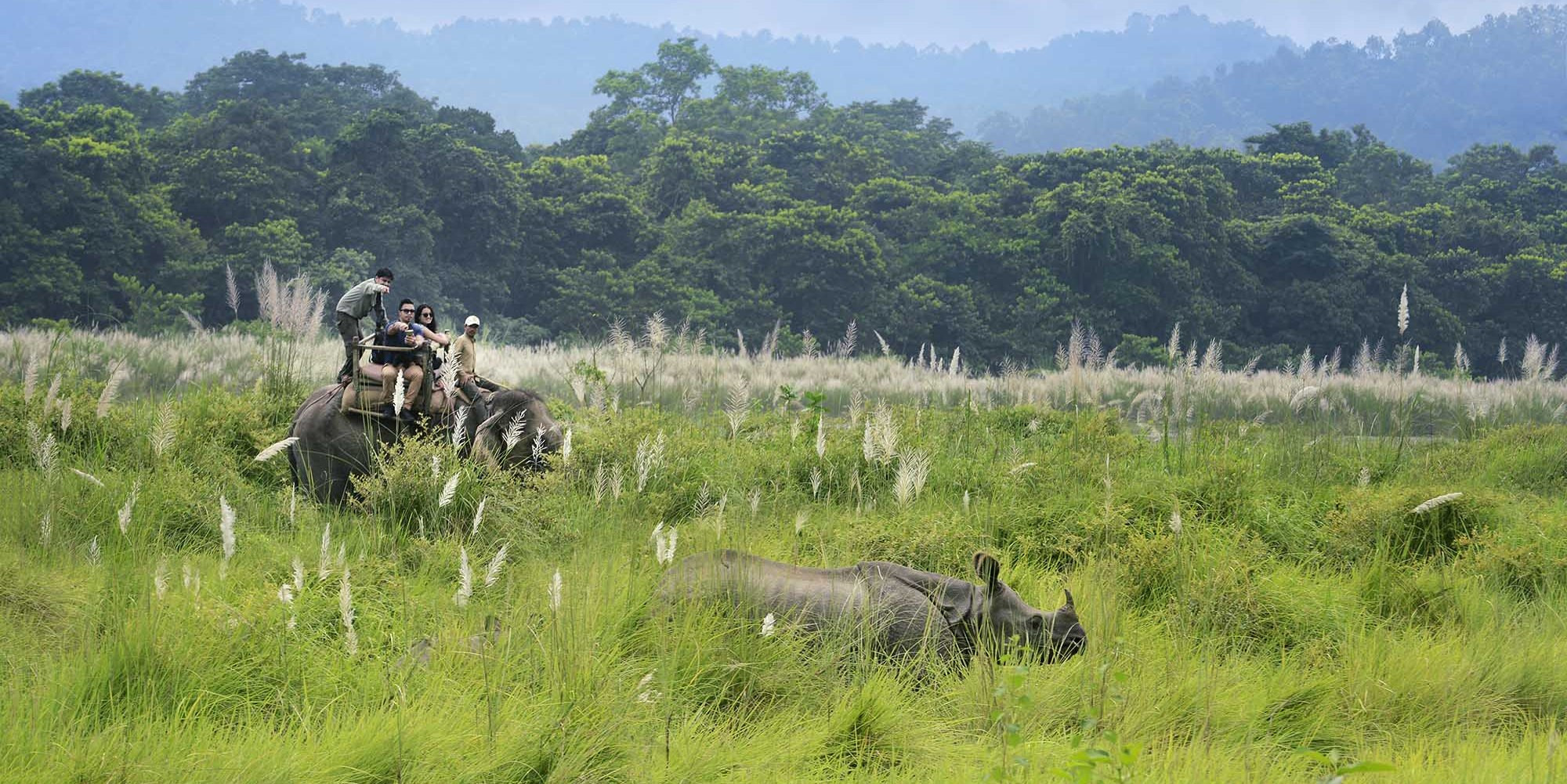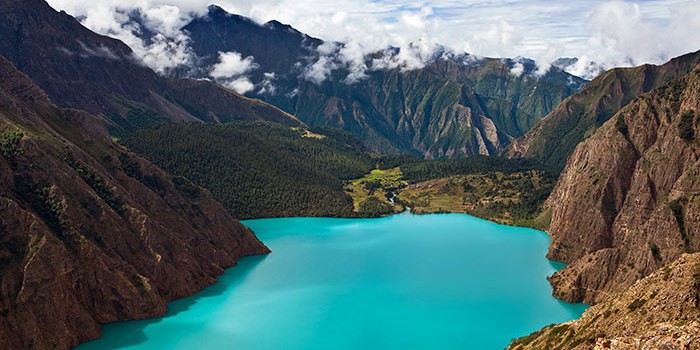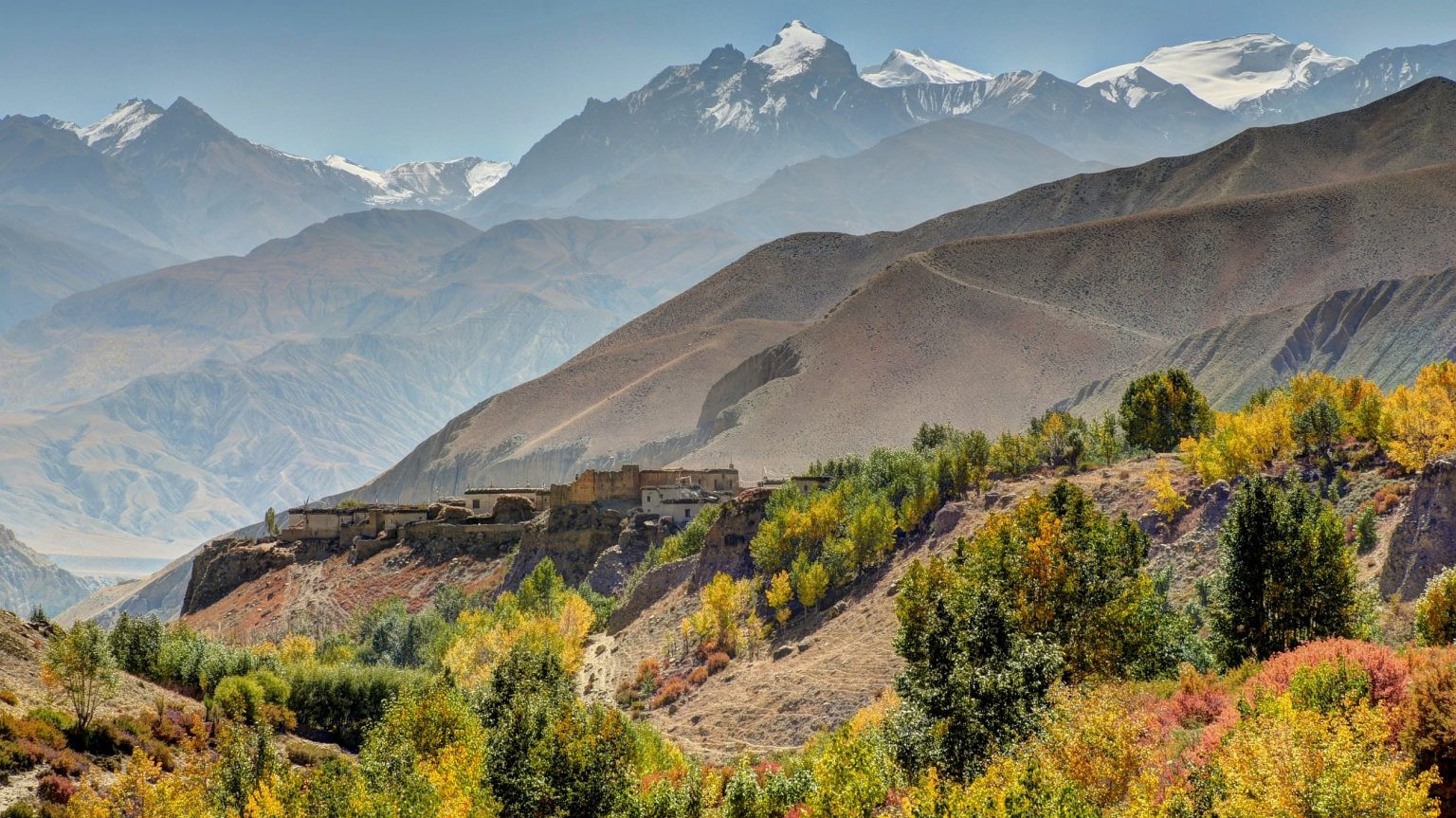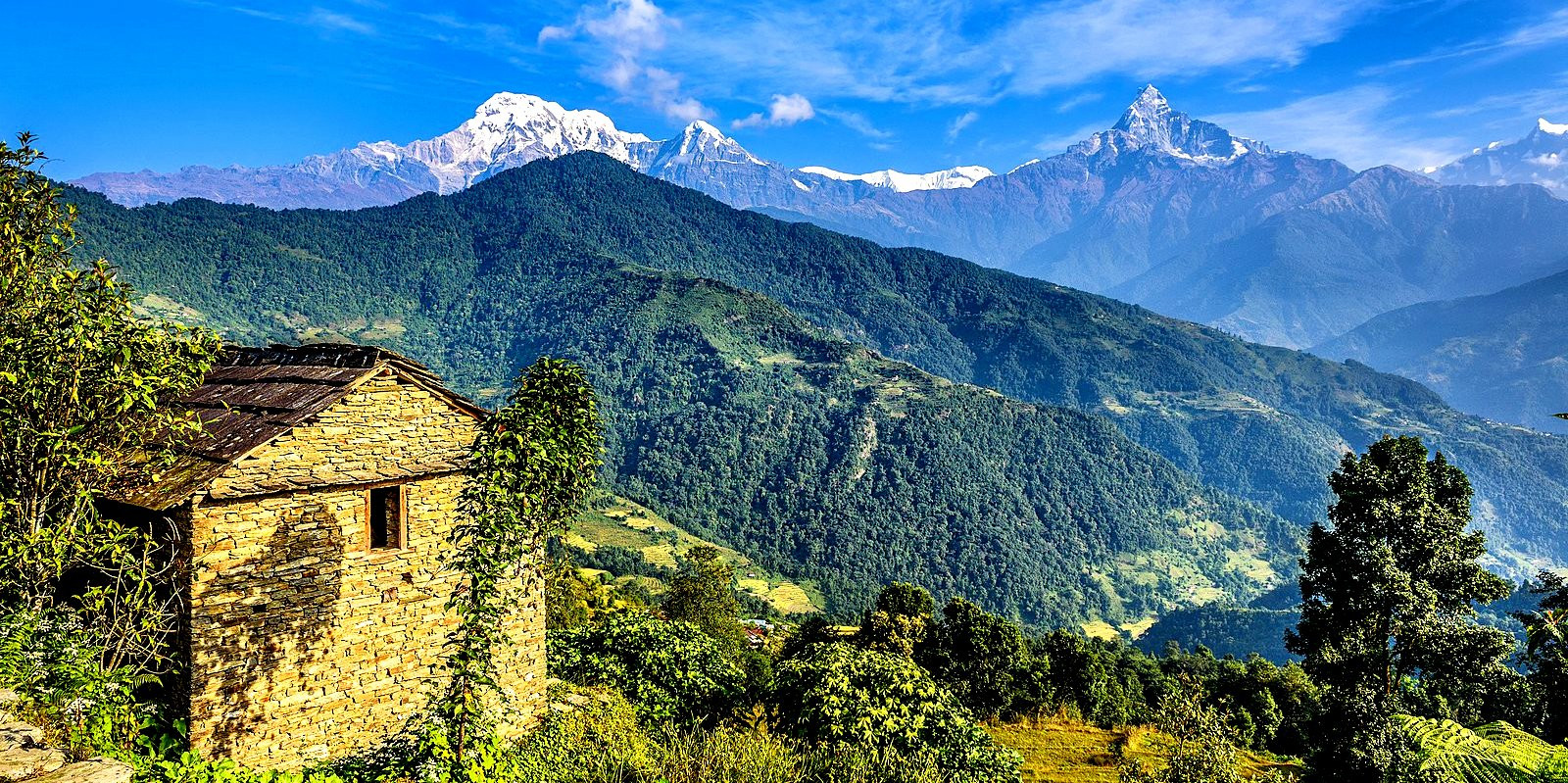Spring in Nepal (March, April, and May)
Spring in Nepal, spanning from March to May, is a season that transforms the country into a vibrant tapestry of colors and life. As the chill of winter recedes, the warmth of spring breathes new life into Nepal's diverse landscapes, making it one of the most favorable times for adventurers, nature lovers, and cultural enthusiasts to visit.

-
Trekking and Outdoor Adventures: Spring is arguably the best season for trekking in Nepal. The weather is moderate, providing comfortable conditions for hiking through the stunning trails of the Everest, Annapurna, and Langtang regions. The snow from winter begins to melt, revealing accessible paths and the lush beauty of the countryside. Trekkers are rewarded with clear, panoramic views of the Himalayas, and the trails are dotted with blooming rhododendrons and a multitude of wildflowers, adding a splash of color to the already breathtaking landscapes.
-
Cultural Festivals: Spring is also a time of celebration in Nepal. The vibrant festival of Holi, also known as the Festival of Colors, takes place in March, marking the victory of good over evil and welcoming the spring with splashes of color and joyous festivities. Another significant spring event is Buddha Jayanti, the birth anniversary of Lord Buddha, celebrated with great reverence in Lumbini (his birthplace) and across Buddhist monasteries in Nepal. These festivals offer a glimpse into the rich tapestry of Nepalese culture and spirituality.
-
Wildlife and Nature: For wildlife enthusiasts, spring is a fruitful season to visit the national parks of Nepal, such as Chitwan and Bardia. The warmer weather increases the chances of sighting wildlife as animals become more active. Moreover, the national parks are alive with fresh foliage, making them even more inviting for nature walks and jungle safaris.
-
Climbing Expeditions: Spring is also the prime season for mountaineering expeditions, including attempts to summit Everest and other high peaks. The stable weather, relatively low winds, and moderate temperatures create optimal conditions for climbers aiming for the highest altitudes.
Spring in Nepal is a season of unparalleled beauty and opportunity. Whether you're trekking through vibrant landscapes, participating in colorful festivals, observing wildlife, or embarking on a climbing expedition, Nepal in spring offers a harmonious blend of adventure, culture, and natural beauty, making it an ideal time for an unforgettable journey.
Summer/Monsoon in Nepal (June, July and August)
Summer in Nepal, which coincides with the monsoon season from June to August, presents a different facet of the country's natural beauty and offers unique experiences for travelers who don't mind embracing a bit of rain. This season transforms the landscape into a lush, verdant paradise, albeit with challenges and surprises due to the rainfall.

-
Lush Landscapes and Agriculture: The monsoon rains rejuvenate the land, filling rivers to the brim and turning the hills vibrant green. This season is particularly fascinating for those interested in agriculture and rural life, as it's a busy time for planting crops. The terraced fields of Nepal come alive with activity, offering a unique insight into the country's agricultural practices and rural lifestyle.
-
Lower Tourist Traffic: Summer is considered off-peak tourist season due to the rains, which means fewer crowds at popular sites and potentially lower prices for accommodation and travel. This can be advantageous for travelers seeking a more solitary or authentic experience in Nepal's cities and villages.
-
Trekking in the Rain Shadow Areas: While the monsoon can make trekking in many parts of Nepal challenging due to slippery trails and obscured mountain views, there are regions that lie in the rain shadow, such as Mustang and parts of Dolpo. These areas receive significantly less rainfall and offer stunning landscapes that are vastly different from the lush greenery found elsewhere in Nepal. Trekking in these areas during the monsoon allows adventurers to explore unique, arid landscapes reminiscent of the Tibetan plateau, with clear skies and fewer tourists.
-
Festivals and Cultural Events: The monsoon season is also a time for important cultural festivals in Nepal. One of the major festivals is Janai Purnima, or the Sacred Thread Festival, where Hindu men renew their Janai and people from various ethnic backgrounds participate in ritual baths and pilgrimages. Another significant event is the Gai Jatra festival, which is celebrated in the Kathmandu Valley with parades, humour, and remembrance of loved ones who have passed away.
-
Wildlife Viewing: The lush vegetation of the monsoon season supports a rich array of wildlife activity, especially in the national parks. While the dense foliage can sometimes make animal sightings more challenging, it's also a time when the flora and fauna are at their most vibrant, offering rewarding experiences for keen wildlife enthusiasts.
The summer/monsoon season in Nepal is a time of flourishing natural beauty, vibrant cultural festivals, and unique trekking opportunities in the rain shadow areas. For those willing to navigate the rainy conditions, this season offers a less crowded and more immersive experience in Nepal's rich landscapes and cultural tapestry.
Autumn in Nepal (September, October, and November)
Autumn in Nepal, stretching from September to November, is widely celebrated as the peak season for visitors seeking to explore the country's legendary landscapes and cultural heritage. This period is characterized by clear skies, mild weather, and the aftermath of the monsoon season, which leaves the countryside lush and green. It's a time when Nepal truly shines, offering optimal conditions for trekking, festivals, and sightseeing.

-
Prime Trekking Season: Autumn marks the best time for trekking in Nepal, with the popular trails to Everest Base Camp and the Annapurna Circuit becoming hubs of activity. The monsoon rains have cleared the air of dust and pollution, resulting in crystal-clear views of the Himalayan peaks. The weather is comfortably cool, neither too hot during the day nor too cold at night, making it ideal for both high-altitude expeditions and leisurely walks in the hills. The trails are lined with an array of flora, and the forests are a vibrant green, providing a stunning backdrop for adventurers.
-
Festive Atmosphere: This season also coincides with some of Nepal's most important festivals, adding a layer of cultural richness to your visit. Dashain, the longest and most auspicious festival in the Nepalese calendar, falls in this period, followed by Tihar, the festival of lights. Both festivals are celebrated with great enthusiasm across the country, offering visitors a chance to experience Nepal's traditions, rituals, and the warmth of Nepalese hospitality.
-
Climbing and Expeditions: Beyond trekking, autumn is also the preferred season for mountaineering expeditions in the Himalayas. Climbers from around the world gather to ascend Nepal's towering peaks, taking advantage of the stable weather and favorable conditions to reach new heights.
-
Wildlife and Nature: The post-monsoon freshness makes autumn an excellent time for wildlife enthusiasts to visit Nepal's national parks, such as Chitwan and Bardia. The clearer skies and cooler temperatures enhance the chances of spotting wildlife, including the Bengal tiger, one-horned rhinoceros, and various bird species.
-
Cultural Exploration and Sightseeing: The pleasant weather and festive mood make autumn an ideal time for cultural exploration and sightseeing in Nepal's cities and villages. The architectural wonders of Kathmandu Valley, the serene beauty of Pokhara's lakeside, and the historical sites of Lumbini are at their most accessible and enjoyable. The air is free of the summer's humidity and the winter's chill, offering perfect conditions for exploring the rich tapestry of Nepal's heritage.
Autumn in Nepal is a season of unparalleled beauty, adventure, and cultural immersion. It offers the best of Nepal's natural landscapes and festive traditions, making it the ideal time for visitors to experience the country's unique charm. Whether you're trekking through the majestic Himalayas, participating in vibrant festivals, or simply soaking in the natural and cultural beauty, autumn promises an unforgettable journey.
Winter in Nepal (December, January, and February)
Winter in Nepal, spanning from December to February, presents a serene and majestic facet of the country's diverse landscapes. During these months, the hustle and bustle of the peak trekking seasons wane, giving way to tranquil trails, snow-draped mountains, and the crisp clarity of winter air. This season offers a unique perspective on Nepal's beauty, appealing to those who appreciate the quiet majesty of the Himalayas and the warmth of Nepalese culture during the cooler months.
 2.jpg)
-
Serene Trekking Experience: While the higher altitudes are colder and some high passes may be closed due to snow, several trekking routes in the lower Himalayan ranges remain accessible and less crowded. Trails like the Ghorepani Poon Hill trek offer spectacular sunrise views over snow-capped peaks with fewer trekkers on the path. The winter landscape is stark yet stunning, with clear skies providing excellent visibility of the Himalayan range.
-
Festivals and Culture: Winter is also a time of cultural festivities in Nepal. The Tibetan New Year, or Losar, falls in this season, celebrated with great zeal in the Himalayan regions. The Maghe Sankranti festival, marking the end of the winter solstice, brings families together for feasts and rituals, offering visitors a glimpse into the rich tapestry of Nepalese traditions.
-
Wildlife Viewing: The cooler temperatures of winter reduce the dense foliage in Nepal's jungles, increasing the chances of wildlife sightings during safaris in national parks like Chitwan and Bardia. The lower water levels in the rivers also attract a variety of birds, making it an ideal season for bird watching.
-
Peaceful Sightseeing: For those interested in cultural sightseeing and exploring Nepal's historical heritage without the crowds, winter is an opportune time. The Kathmandu Valley, with its plethora of UNESCO World Heritage sites, is less crowded, allowing for a more relaxed exploration of its ancient temples, stupas, and palaces. The cooler weather is well-suited for leisurely walks through the old towns and markets, offering a deeper connection with the local way of life.
-
Winter Sports and Activities: In recent years, Nepal has begun to offer more in the way of winter sports, including skiing and snowboarding in certain areas. The growing interest in these activities provides an exciting new way to experience the Nepalese Himalayas during the winter months.
Winter in Nepal is a season of quiet beauty, cultural richness, and unique outdoor adventures. It appeals to those who prefer a more solitary exploration of the Himalayas and wish to experience Nepal's cultural festivities without the peak season crowds. Whether you're trekking through peaceful trails, participating in traditional festivals, or enjoying the wildlife and historical sites, winter in Nepal offers a distinct and memorable experience.
Choosing the best time to visit Nepal hinges on your interests and the experiences you seek in this diverse country. Each season unfolds unique charms: spring offers vibrant blooms and ideal trekking conditions; summer showcases lush landscapes despite the monsoon; autumn presents clear skies and cultural festivities, making it the peak trekking season; and winter introduces serene landscapes with fewer crowds. Whether you're drawn to outdoor adventures, cultural explorations, or the tranquilly of nature, Nepal's seasonal diversity ensures your trip will be memorable. At Relax Getaways, we're here to guide you through Nepal's seasonal offerings, ensuring your adventure aligns perfectly with your expectations and the country's natural rhythm.
FAQs for Best Time to Visit Nepal: Discover the Perfect Seasons for Unforgettable Experiences
Q: What is the best season for trekking in Nepal?
A: Autumn (September to November) is typically the best season for trekking due to clear skies and stable weather. Spring (March to May) also offers great trekking conditions with less crowded trails and vibrant natural scenery.
Q: Can I visit Nepal during the monsoon season?
A: Yes, the monsoon season (June to August) is suitable for visiting the less rainy areas like Mustang and Dolpo, which offer unique trekking experiences. It's also a good time for cultural explorations without crowds.
Q: Is winter a good time to visit Nepal?
A: Winter (December to February) is ideal for those who enjoy serene landscapes and cooler weather. While high-altitude trekking might be challenging, many lower altitude areas offer pleasant weather for sightseeing.
Q: What are the major festivals I can experience in Nepal?
A: Nepal's major festivals include Dashain and Tihar in autumn, Holi in spring, and Losar in winter. These festivals provide a wonderful opportunity to experience the rich culture and traditions of Nepal.
Q: Are there any activities for non-trekkers in Nepal?
A: Absolutely! Non-trekkers can enjoy cultural tours, wildlife safaris, paragliding, rafting, and scenic flights over the Himalayas, among other activities that showcase the diversity of Nepal's landscapes and cultures.
Q: What should I pack for a trip to Nepal?
A: Essential items include layered clothing, sturdy hiking boots (if trekking), rain gear for monsoon visits, warm clothing for winter, sun protection, and any personal medication. Adapting your packing list to the season and activities planned is key.
Q: How can I ensure a responsible and sustainable visit to Nepal?
A: Ensure a responsible visit by staying in eco-friendly accommodations, respecting local customs, minimising waste, supporting local businesses, and being environmentally conscious, especially in natural and rural areas.
Q: Is it safe to travel solo in Nepal?
A: Nepal is generally safe for solo travellers. However, it's important to follow general safety precautions, stay informed about local conditions, and respect local advice, especially when trekking or exploring remote areas.
Q: How can I deal with altitude sickness in Nepal?
A: Prevent altitude sickness by acclimatising properly, ascending gradually, staying hydrated, avoiding alcohol and tobacco, and descending immediately if symptoms worsen. Recognising early symptoms is crucial.
Q: Can I get it by speaking English in Nepal?
A: English is widely spoken in tourist areas, including major cities and trekking regions. You'll find that many people in these areas can communicate effectively in English, making it easier for travelers.
For the Nepal Tour Details, please Nepal Tour Packages
If you are looking for different kinds of Nepal Packages, feel free to contact us.





 2.jpg)